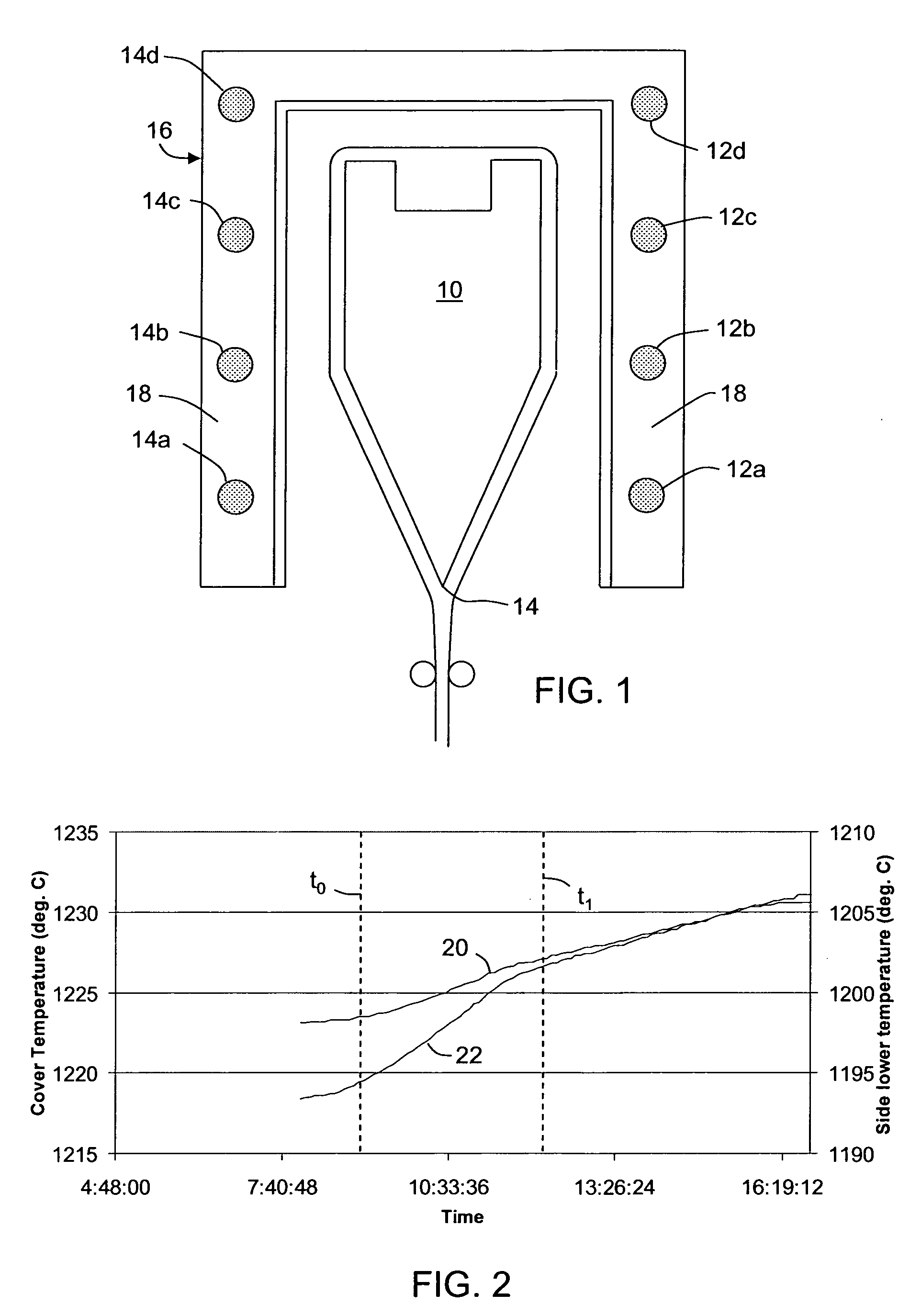Method and apparatus for minimizing inclusions in a glass making process
a glass making process and inclusion technology, applied in glass rolling apparatus, glass tempering apparatus, manufacturing tools, etc., can solve the problems of secondary zircon crystals becoming more pronounced, and ultimately affecting the quality of glass
- Summary
- Abstract
- Description
- Claims
- Application Information
AI Technical Summary
Benefits of technology
Problems solved by technology
Method used
Image
Examples
example 1
[0057]Shown in FIG. 11 are additional modeling data showing the predicted difference for the formation of precipitated zircon for a base case without a barrier (curve 600) and the case with an insulating thermal barrier between the bottom-most heating elements and the next vertically adjacent heating element (curve 602). The glass flow was assumed to be about 1500 pounds per hour. Isopipe temperatures at the weir, break and root for the base case, depicted by curve 600, were 1232° C., 1213° C. and 1153° C., respectively. The same temperatures with the insulating thermal shield (weir, break and root), depicted by curve 602, were 1228° C., 1205° C. and 1159° C., respectively. Precipitated zircon crystals (“secondary” zircon) form on the isopipe as a result of the supersaturation of ZrO2 at the isopipe-glass interface as the glass melt flows over the isopipe. To determine the presence of supersaturation, it is necessary to know the ZrO2 concentration profile in the glass melt and to co...
example 2
[0058]Shown in FIG. 12 is a chart plotting on the left hand axis power supplied to heating elements in kW, on the right hand axis the temperature differential between the weirs and the root, and along the bottom axis (x axis) time in hours for a conventional isopipe and enclosure. Four curves are shown: three curves representing the power supplied to three heating zones; one heating zone below the root (the “transition” zone), a lower muffle heating zone proximate the root (i.e. the “bottom-most” heating element as used herein, e.g. 12a), and an upper muffle heating zone (heaters above the bottom-most heating element, e.g. 12b, c and d). These curves are respectively referenced as curves 700, 702 and 704. Fourth curve 706 represents the temperature differential between the weirs and root of the isopipe.
[0059]Shown in FIG. 13 is a chart plotting on the left hand axis power supplied to heating elements in kW, on the right hand axis the temperature differential between the weirs and th...
PUM
| Property | Measurement | Unit |
|---|---|---|
| temperature | aaaaa | aaaaa |
| thickness | aaaaa | aaaaa |
| temperature | aaaaa | aaaaa |
Abstract
Description
Claims
Application Information
 Login to View More
Login to View More - R&D
- Intellectual Property
- Life Sciences
- Materials
- Tech Scout
- Unparalleled Data Quality
- Higher Quality Content
- 60% Fewer Hallucinations
Browse by: Latest US Patents, China's latest patents, Technical Efficacy Thesaurus, Application Domain, Technology Topic, Popular Technical Reports.
© 2025 PatSnap. All rights reserved.Legal|Privacy policy|Modern Slavery Act Transparency Statement|Sitemap|About US| Contact US: help@patsnap.com



